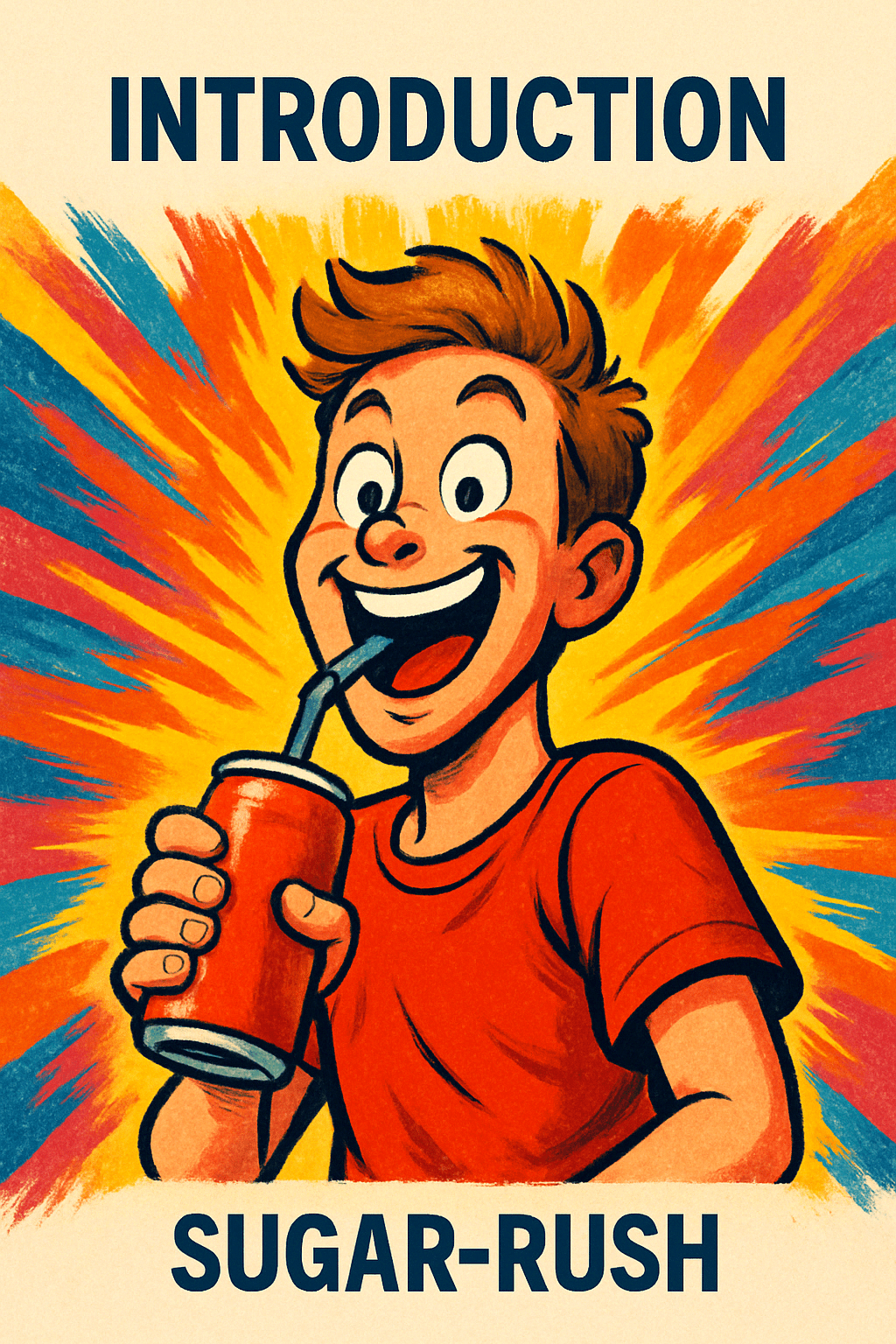In today’s fast-moving world, sugar-laden snacks and drinks are everywhere. They’re easily accessible, heavily marketed, and often consumed without much thought—especially when we need a quick energy fix. Most of us are familiar with the term “sugar rush,” and we may even use it to describe the energetic or hyper behavior we feel after indulging in something sweet. But what is a sugar rush from a scientific perspective? And more importantly, how long does a sugar rush last before the inevitable crash?
These are not trivial questions. They go to the heart of how food choices influence our energy levels, brain function, metabolic health, and emotional well-being. For people trying to practice mindful eating or build a healthier lifestyle, understanding what’s really going on during a sugar rush can be eye-opening—and life-changing.
You may also like: Why Am I Craving Sweets All of a Sudden? Expert-Backed Reasons and How to Stop Sugar Cravings Naturally
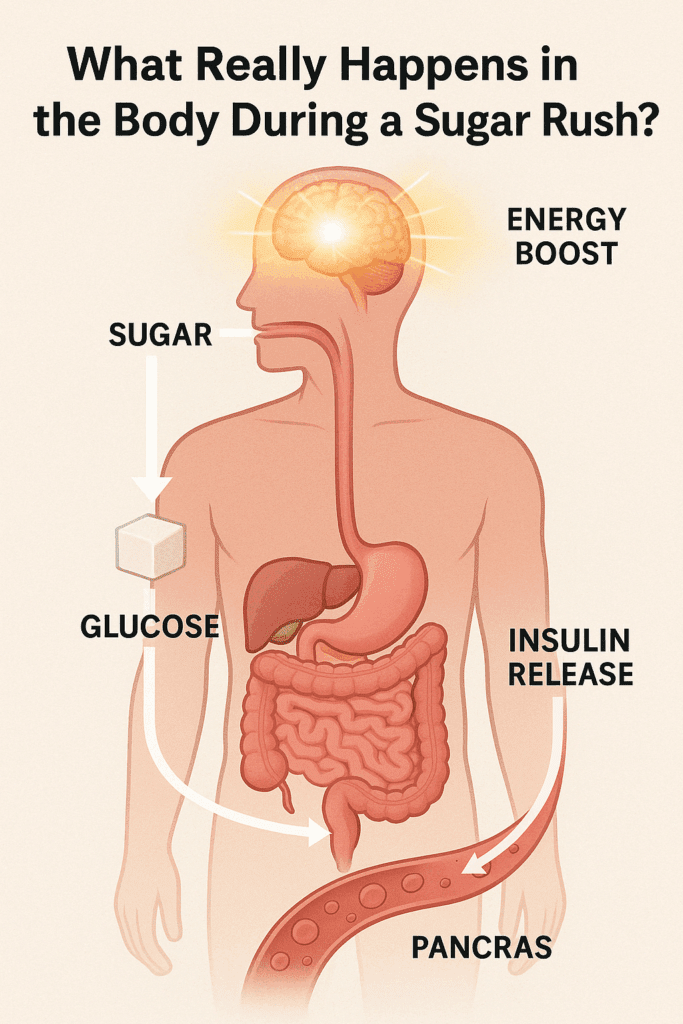
What Really Happens in the Body During a Sugar Rush?
To answer the question “what is a sugar rush,” we first need to understand how sugar is processed in the body. When you eat something high in sugar—especially refined sugar without fiber, fat, or protein—your body digests it rapidly. The sugars break down into glucose, which quickly enters the bloodstream and raises your blood sugar levels.
This sudden spike prompts the pancreas to release insulin, a hormone that helps transport glucose into your cells for energy. During this phase, people often feel an increase in mental alertness, energy, and even happiness. The body and brain are literally being flooded with fuel. In fact, the brain relies almost exclusively on glucose for energy, so it’s no surprise that we feel temporarily “switched on” during this initial surge.
However, this high doesn’t last long. When the insulin response kicks in strongly—especially after a large or refined sugar load—it can cause blood sugar levels to drop just as quickly as they rose. This crash can leave you feeling tired, irritable, hungry, or foggy-headed. It’s this rollercoaster ride of energy that defines the full experience of a sugar rush and crash cycle.
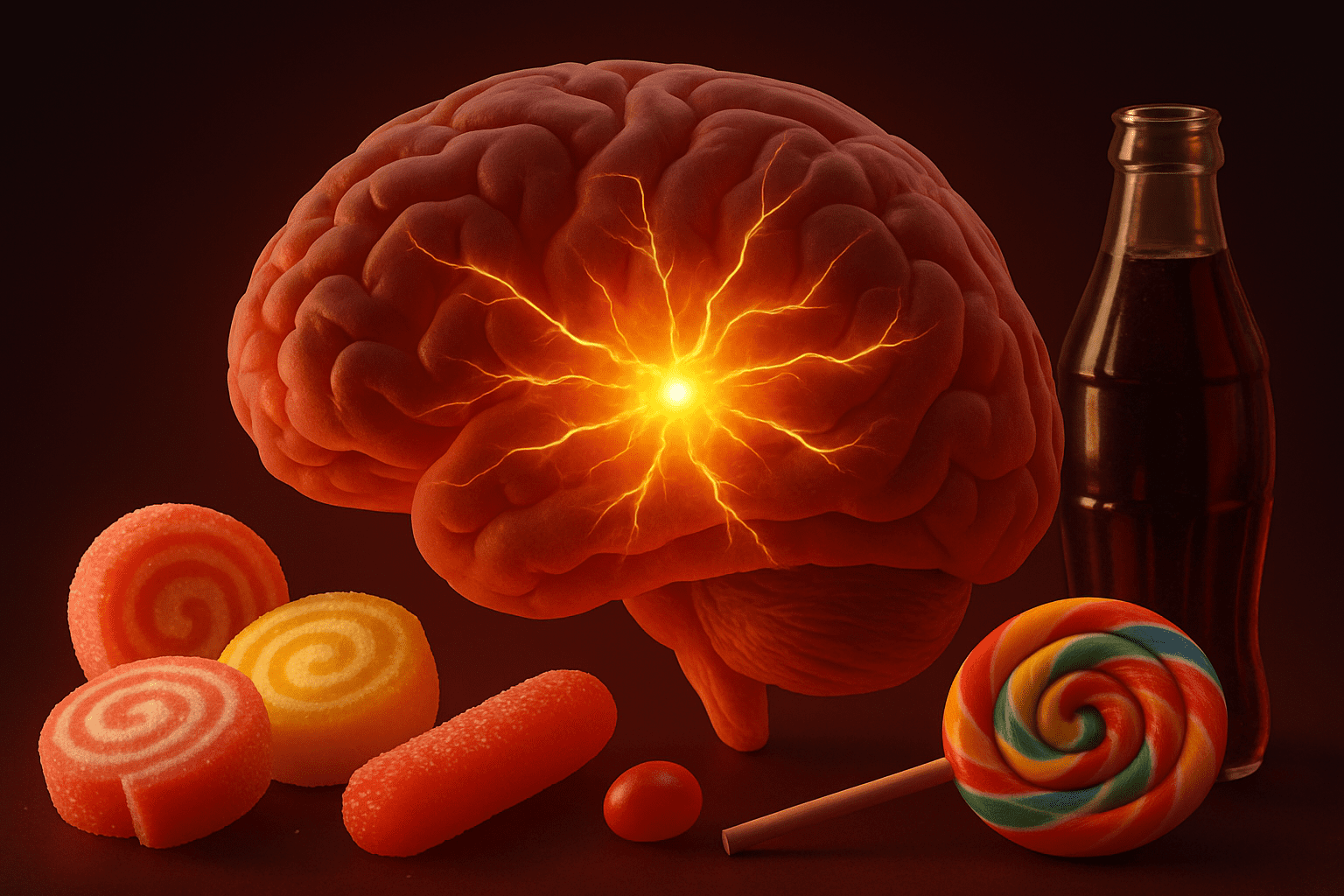
How Sugar Affects the Brain and Why It Feels So Good
While the metabolic effects of sugar are well understood, the brain’s response is equally important in answering what is a sugar rush. Sugar activates the brain’s reward center by triggering the release of dopamine, a feel-good neurotransmitter associated with pleasure and reward. This effect is similar, though milder, to that of other addictive substances, and it helps explain why sugar can be so difficult to resist.
The dopamine release makes us feel temporarily euphoric or satisfied, reinforcing the behavior of eating sugar again. This positive feedback loop becomes especially problematic when sugar is consumed frequently or in large quantities. Over time, more sugar may be needed to achieve the same level of satisfaction, and withdrawal from it can trigger irritability or fatigue.
So, what we call a sugar rush is actually a combination of two systems at work: the physiological rise in blood glucose and the neurological surge in dopamine. Together, these create that fleeting sense of energy and happiness that often has us reaching for another cookie, soda, or candy bar.
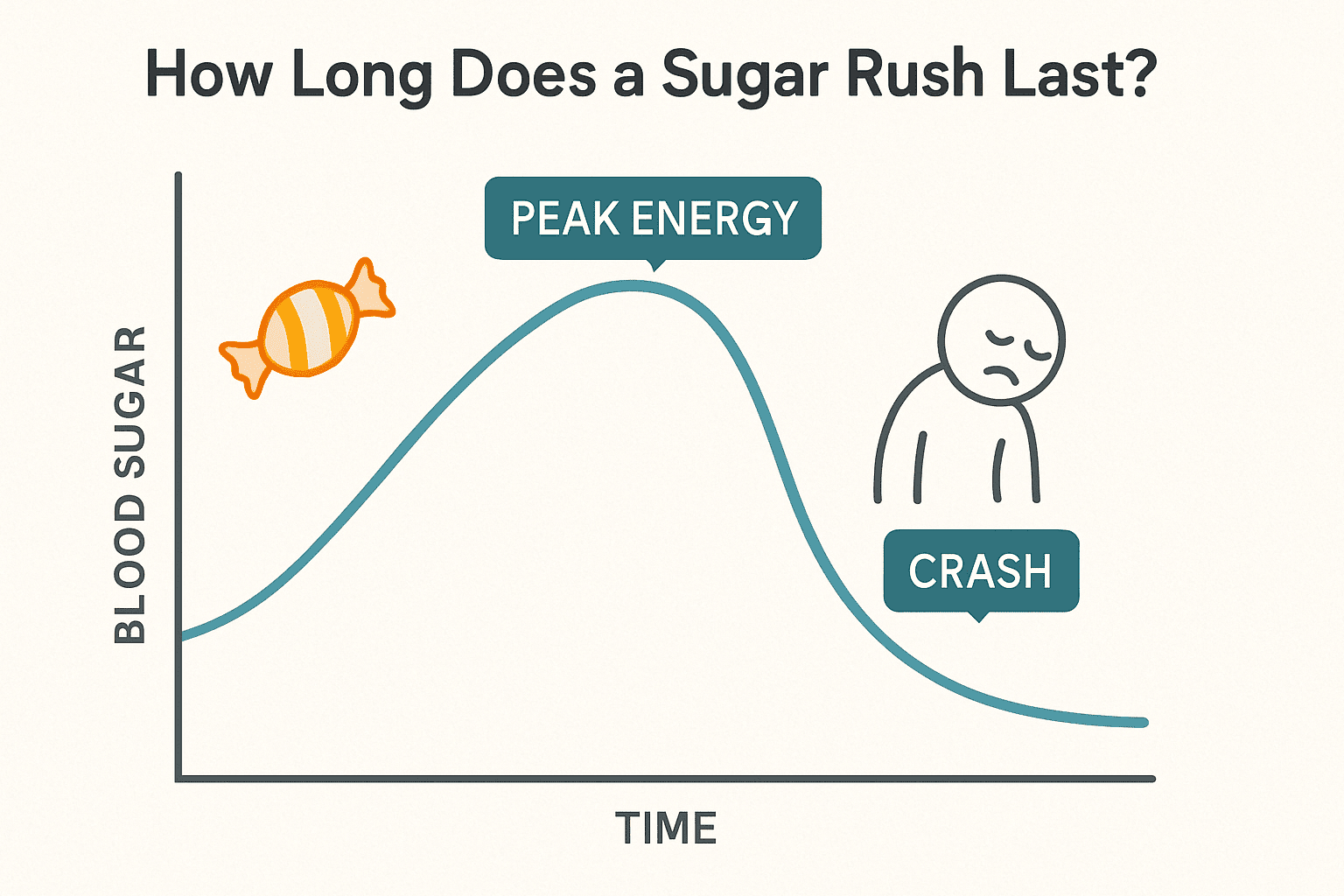
How Long Does a Sugar Rush Last?
Now let’s dive into the second question: how long does a sugar rush last? In most cases, the rush begins within 10 to 20 minutes after consuming sugar, as glucose levels rise rapidly in the blood. This is especially true for foods or drinks that are high in simple sugars and low in fiber or fat, such as candy, soda, or white bread.
The feeling of increased energy usually peaks between 30 and 60 minutes after consumption. However, this high is often short-lived. As insulin clears the sugar from your bloodstream, blood glucose levels can drop below normal, leading to symptoms like sluggishness, brain fog, headaches, or intense hunger. This is the infamous “sugar crash,” and it can last anywhere from one to three hours depending on your metabolism and what else you’ve eaten.
So in total, how long does a sugar rush last? From the onset to the crash, the full cycle typically spans about two to three hours. But the aftereffects—like fatigue or sugar cravings—can linger even longer, especially if the rush is followed by another dose of sugar, perpetuating the cycle.
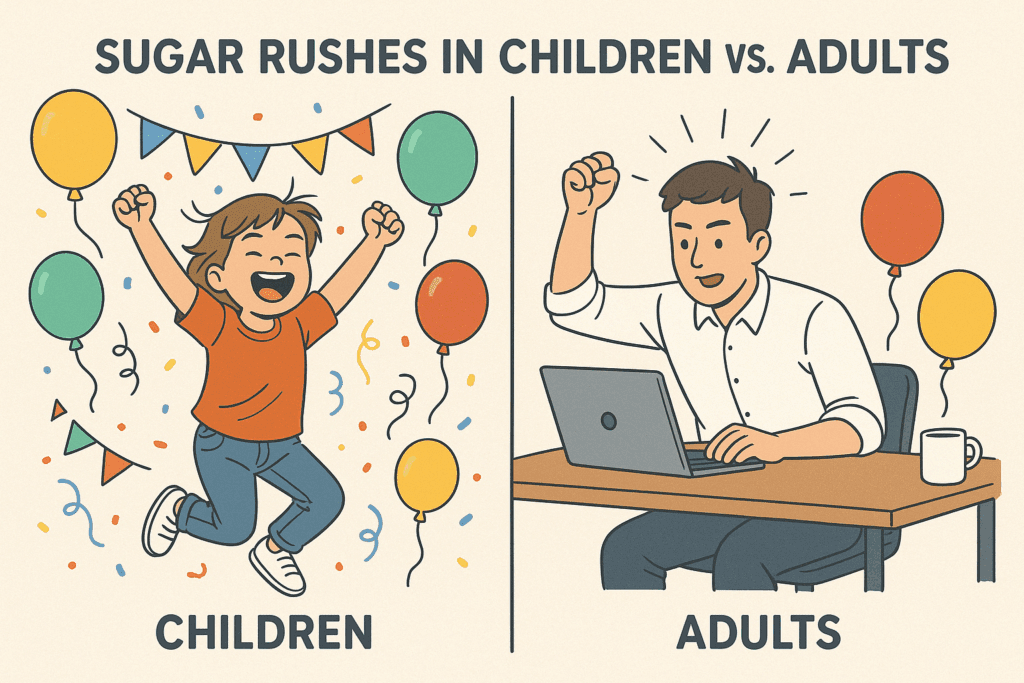
Sugar Rushes in Children vs. Adults
Parents often describe their children as “bouncing off the walls” after birthday cake or Halloween candy, reinforcing the idea that kids are especially sensitive to sugar. While some studies have suggested that the link between sugar and hyperactivity in children is more myth than fact, newer research highlights that there are measurable changes in energy, mood, and behavior related to glucose fluctuations in both kids and adults.
Children may experience more noticeable sugar rush symptoms simply because their bodies are smaller and more reactive to blood sugar changes. Additionally, sugary treats are often consumed during exciting events—like holidays or parties—so the environment itself may amplify sugar’s perceived effects.
Adults, on the other hand, might not bounce off the walls, but they do experience sugar rushes in more subtle ways—like a sudden spike in productivity or a short-lived feeling of mental clarity. The crash that follows, however, can be just as pronounced, often manifesting as afternoon fatigue or irritability at work.
Regardless of age, the sugar rush phenomenon follows a similar pattern: fast energy up, fast energy down. And once you understand what is a sugar rush and how it plays out in real time, you can take steps to break the cycle.
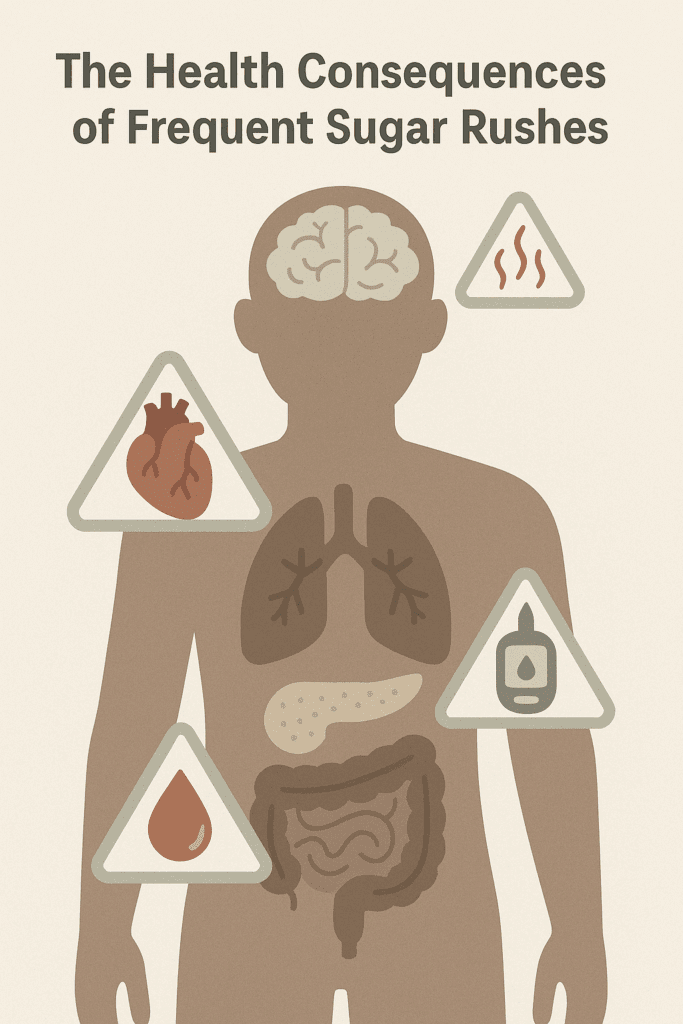
The Health Consequences of Frequent Sugar Rushes
An occasional sugar rush is unlikely to cause serious harm. However, when these episodes become frequent—especially in the context of a diet high in processed foods—they can lead to lasting health problems. Each rush and crash cycle stresses the body’s insulin response, and over time, this can contribute to insulin resistance. That’s the first step on the path toward metabolic disorders like prediabetes and type 2 diabetes.
Frequent blood sugar swings can also promote chronic inflammation, a major underlying factor in many diseases, including heart disease, obesity, and even some forms of cancer. Beyond the physical effects, the mental health implications are significant too. Mood swings, anxiety, and difficulty concentrating can all be worsened by unstable blood sugar.
Additionally, the brain’s reward circuitry doesn’t forget the pleasure of the sugar rush. This makes it all too easy to fall into a pattern of emotional eating, especially during times of stress or fatigue. Recognizing how long does a sugar rush last and how quickly the crash sets in can help people avoid using sugar as a coping mechanism—and instead find more sustainable ways to boost mood and energy.

Strategies to Avoid Sugar Rushes and Maintain Stable Energy
If you’re looking to minimize sugar rushes, the key lies in stabilizing your blood sugar through balanced meals. A good rule of thumb is to combine complex carbohydrates with protein and healthy fats. For example, instead of reaching for a plain piece of toast, try avocado toast with a poached egg. The fiber, fat, and protein all slow digestion, preventing a spike in glucose.
Mindful eating can also help. Eating slowly, avoiding distractions, and paying attention to hunger and fullness cues can prevent overeating and reduce cravings for quick-fix sugar. When you’re emotionally triggered to reach for a sweet treat, pause and ask yourself what you really need. Sometimes it’s rest, hydration, or connection—not sugar.
Another effective strategy is to identify hidden sugars in your diet. Many processed foods contain added sugars under names like “maltose,” “corn syrup,” or “evaporated cane juice.” Learning to read labels and choosing whole, minimally processed foods can dramatically reduce your overall sugar intake.

Recovering from a Sugar Crash: What to Do After the Rush
If you’ve already experienced a sugar rush and feel the crash coming on, there are healthy ways to support your body as it rebalances. Start by hydrating. Sugar can cause a diuretic effect, leaving you slightly dehydrated, which can worsen fatigue and headaches.
Then, stabilize your blood sugar by eating a nutrient-dense snack with protein and fiber. Think along the lines of almond butter on whole-grain crackers or a small smoothie with greens and chia seeds. These foods provide steady energy and help bring your blood sugar back to baseline.
Finally, gentle movement—like a 10-minute walk—can help your body metabolize excess glucose more efficiently and reduce the impact of the crash. Light exercise improves insulin sensitivity and encourages muscle cells to absorb glucose, which can help ease symptoms more quickly.
Frequently Asked Questions: Sugar Rushes, Crashes, and Energy Regulation
1. Can a sugar rush affect your decision-making or judgment?
Absolutely. While most people associate sugar rushes with energy and hyperactivity, they can also subtly impair executive function. When glucose levels spike quickly, they can temporarily overstimulate areas of the brain responsible for reward and impulsivity. This altered brain chemistry can lead to more impulsive decisions, especially around food or time management. For example, individuals in the midst of a sugar rush may be more likely to make rash choices or seek additional instant gratification. So while the question “what is a sugar rush” often focuses on energy, the answer should also include its psychological influence on self-control and rational thought.
2. How long does a sugar rush last when you consume sugar with protein or fat?
The duration and intensity of a sugar rush can be significantly modified when sugar is consumed alongside other macronutrients. If you eat a high-sugar food with protein, fiber, or healthy fats, the absorption of glucose slows down. This dampens the spike in blood sugar and can even prevent a sugar rush from happening in the traditional sense. In this case, how long a sugar rush lasts depends more on the full nutrient composition of the meal than the sugar alone. While the energy boost might be less dramatic, it tends to be more sustained and far less likely to cause a crash.
3. Are some types of sugar more likely to trigger a sugar rush than others?
Yes, not all sugars are metabolized the same way. Simple sugars like glucose and sucrose—commonly found in candy, soda, and pastries—are absorbed rapidly, leading to a more immediate and intense sugar rush. In contrast, natural sugars in fruit come packaged with fiber, water, and micronutrients that slow absorption and reduce the likelihood of a sharp glucose spike. So, when asking what is a sugar rush, it’s crucial to consider not just the amount of sugar, but the source. Foods with high glycemic indexes tend to trigger more powerful rushes and crashes, which can affect both physical energy and emotional stability.
4. Can a sugar rush impact athletic performance or recovery?
Interestingly, sugar rushes can offer short-term performance benefits for athletes engaged in high-intensity, short-duration sports. For example, consuming a quick source of sugar before or during a sprint or a weightlifting session may improve immediate energy output. However, how long does a sugar rush last in these situations is still limited—typically no more than an hour—and may lead to premature fatigue if not managed properly with balanced nutrition. Post-exercise, pairing carbohydrates with protein is more effective for recovery than relying on sugar alone. Athletes should be cautious about overusing sugar as a performance enhancer due to its inconsistent long-term effects.
5. Can the brain become dependent on sugar rushes for focus or mood regulation?
Yes, and this is an emerging area of concern among neuroscientists and psychologists. People who frequently rely on sugary snacks to “wake up” or elevate their mood can develop a psychological dependency on sugar-triggered dopamine spikes. Over time, the brain may associate productivity or happiness with sugar intake, leading to habitual cravings. When you consider what is a sugar rush from this angle, it becomes more than a metabolic event—it’s a behavioral loop reinforced by the brain’s reward system. Breaking this cycle often requires deliberate effort, including blood sugar stabilization, stress management, and reconditioning emotional responses to food.
6. How long does a sugar rush last in someone with insulin resistance?
In individuals with insulin resistance, how long does a sugar rush last is a more unpredictable question. Since their cells don’t respond effectively to insulin, glucose may remain in the bloodstream longer, prolonging the sugar rush and increasing the potential for damage. The rush may feel more extended, but the energy might be uneven or accompanied by symptoms like fatigue, fogginess, or thirst. Additionally, the crash that follows can be more intense because insulin regulation is impaired. For these individuals, even moderate sugar intake can trigger exaggerated fluctuations in energy and mood, highlighting the importance of medical and nutritional management.
7. What role does sleep play in sugar rush sensitivity?
Poor sleep quality can heighten your sensitivity to sugar rushes by altering glucose metabolism and hunger hormones like ghrelin and leptin. After a night of inadequate sleep, the body tends to crave quick sources of energy—namely sugar—and responds more dramatically to glucose intake. In this state, what is a sugar rush becomes a more volatile experience, as blood sugar and insulin levels fluctuate more erratically. Moreover, how long does a sugar rush last may be extended or feel more disorienting due to the body’s already compromised metabolic and cognitive state. Prioritizing good sleep hygiene is a powerful yet underappreciated tool in stabilizing energy and reducing sugar-related mood swings.
8. Are sugar rushes more likely to happen in stressful situations?
Yes, and there’s a fascinating intersection between stress and sugar metabolism. When under acute stress, the body releases cortisol, a hormone that temporarily elevates blood sugar to provide quick energy for a “fight or flight” response. If sugar is consumed during this time, it compounds the glucose spike, making the sugar rush feel more intense. Additionally, stress weakens the body’s ability to manage insulin effectively, prolonging how long a sugar rush lasts and intensifying the crash that follows. Understanding what is a sugar rush in the context of stress also emphasizes the importance of emotional regulation and stress management strategies in nutritional health.
9. Can a sugar rush affect your immune system?
Surprisingly, yes. Short-term spikes in blood sugar—even from a single sugar rush—have been shown to temporarily suppress immune function. High glucose levels can impair the ability of white blood cells to respond to pathogens, reducing the body’s frontline defenses. If you’re asking what is a sugar rush from an immune perspective, it’s more than just a metabolic shift—it’s a potential immune burden. This is particularly concerning during cold and flu season or for individuals with autoimmune conditions. While how long does a sugar rush last is usually measured in hours, its immunosuppressive effects may linger beyond the obvious energy crash.
10. How can people transition away from relying on sugar rushes for energy?
Reducing dependency on sugar rushes starts with strategic nutritional planning. Instead of looking at what is a sugar rush as an inevitable part of daily life, consider it a signal that your body is seeking fast energy—often because it wasn’t properly nourished earlier. Building meals around complex carbohydrates, lean proteins, and healthy fats provides more sustained energy and prevents the spike-crash cycle. Additionally, focusing on hydration, regular movement, and sleep quality can minimize the body’s perceived need for a quick sugar fix. As your energy stabilizes naturally, you’ll find yourself wondering less about how long a sugar rush lasts and more about how to maintain balanced energy throughout the day.
Conclusion: Why Sugar Awareness Is Key to Better Energy and Long-Term Health
Ultimately, understanding what is a sugar rush and how long does a sugar rush last equips you with knowledge that goes far beyond fleeting energy swings. It reveals how intimately connected our dietary choices are with our emotional balance, mental clarity, and long-term metabolic health. A sugar rush might feel fun or even necessary in the moment, especially when you’re tired or craving comfort. But the temporary high is often followed by a taxing low—and that repeated cycle can take a toll on the body and brain over time.
The good news is that sugar’s effects are not irreversible. Through mindful eating, balanced nutrition, and better awareness of your body’s signals, you can reduce your reliance on sugar and prevent the rollercoaster of highs and crashes. Whether your goal is to feel more energized throughout the day, think more clearly, or build better eating habits for the future, recognizing the short- and long-term effects of sugar is a powerful first step.
By learning to spot the signs of a sugar rush and understanding how long a sugar rush lasts, you can take back control over your energy, your mood, and your health—one thoughtful bite at a time.
Was this article helpful? Don’t let it stop with you. Share it right now with someone who needs to see it—whether it’s a friend, a colleague, or your whole network. And if staying ahead on this topic matters to you, subscribe to this publication for the most up-to-date information. You’ll get the latest insights delivered straight to you—no searching, no missing out.
Further Reading:
Sugar Rush or Crash? Effects of Sugar on Your Energy Levels
Can You Really Have a ‘Sugar High’ or a ‘Sugar Crash’?
The Science Behind the Sugar Rush
Disclaimer
The information contained in this article is provided for general informational purposes only and is not intended to serve as medical, legal, or professional advice. While NewsHealthWatch strives to present accurate, up-to-date, and reliable content, no warranty or guarantee, expressed or implied, is made regarding the completeness, accuracy, or adequacy of the information provided. Readers are strongly advised to seek the guidance of a qualified healthcare provider or other relevant professionals before acting on any information contained in this article. NewsHealthWatch, its authors, editors, and contributors expressly disclaim any liability for any damages, losses, or consequences arising directly or indirectly from the use, interpretation, or reliance on any information presented herein. The views and opinions expressed in this article are those of the author(s) and do not necessarily reflect the official policies or positions of NewsHealthWatch.

